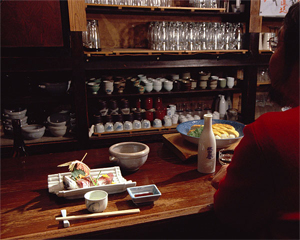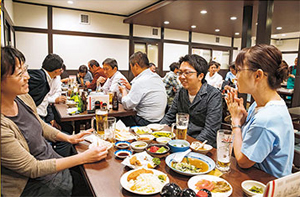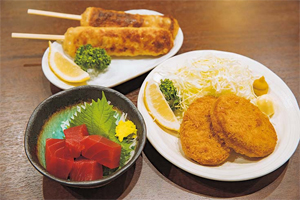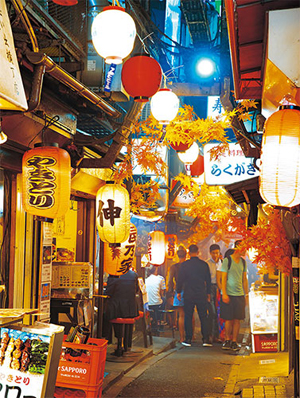

Unwind at an Izakaya
|
One of the dining establishments that is ubiquitous in and unique to Japan is izakaya, be it small, local establishments or large izakaya chains. The word ‘izakaya’ (居酒屋) literally means “stay-drink-place”, which suggests that it is a place to get a drink. While izakaya may be referred to as a Japanese pub or bar, its atmosphere tends to be cosier and the menu is more diverse.
In the past, there were sake stores which used to offer different types of sake for customers to sample, and sold it by volume. Customers would sometimes stay to discuss while drinking on the spot. By the end of the 16th century, shops began serving simple meals, and this slightly resembles the izakaya that we know today. In 1657, the government made it a requirement for sake brewers to purchase licenses. This prompted many sake stores to just sell sake purchased from elsewhere, instead of brewing it from scratch. This marked the beginning of modern-day izakaya. By the early 1800s, many izakaya establishments popped up all over Edo due to a few reasons. Back then, dining out was usually less expensive and more convenient than dining at home. It also became common for workers to gather and socialise over a drink after work. Most izakayas sold sake at different grades and prices, rather than brand names. After Japan opened its borders to foreign trade following the Meiji restoration, izakayas also began to serve alcohol from overseas, such as beer and whisky. As prices gradually decreased, beer has become one of the most popular drinks to order at an izakaya. Today, it is typical for izakaya to hang a nawa noren (rope half curtain) at the entrance, in order to attract customers with the delicious aroma of food. The food menu may vary from place to place, and usually varies by season. Typical dishes can include yakitori, grilled fish, pickles, sashimi, edamame fried chicken or tamagoyaki. There are also more filling dishes such as onigiri and ramen, or even Western dishes such as potato salad and pizza. Generally, the dishes are meant to pair well with drinking. You can easily find an izakaya in Japan if you visit a yokocho (alleyway). Within the narrow streets, you would find them packed with dozens of restaurants, shops and of course, izakayas. As you may expect, you can find yokocho near major neighbourhoods and business districts, so the area would be bustling with life after working hours. If you wish to have a taste of the izakaya atmosphere, you can try visiting some popular areas in Tokyo that have yokocho such as central Shinjuku and Shibuya, Ebisu and Shimbashi. |
 © Iida Yasukuni  © PIXTA  © PIXTA  © PIXTA |
Resources
|
Otani, Hiromi. 2008. “Relax at a Japanese Tavern with Seasonal Sake and Food: Izakaya”. NIPPONIA. https://web-japan.org/nipponia/nipponia44/en/appetit/index.html . “Izakaya : Japan’s unique take on the pub”. 2020. Tokyo Convention & Visitors Bureau. https://www.gotokyo.org/en/story/guide/pub-grub-decoded-a-guide-to-japanese-izakaya/index.html. “Izakaya: the Japanese Tavern”. 2024. Gochiso History. Accessed 17 April. https://gochisohistory.com/izakaya/. Rath, Eric C.. 2021. “Drinking in Tradition: A Short History of Izakaya”. SAKETIMES. https://en.sake-times.com/learn/a-short-history-of-izakaya. |
|
Japan Creative Centre 4 Nassim Road, Singapore 258372 +65 6737 0434 / jcc@sn.mofa.go.jp https://www.sg.emb-japan.go.jp/JCC/ Nearest parking at Orchard Hotel & Delphi Orchard |
 |